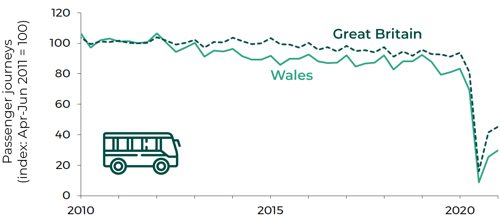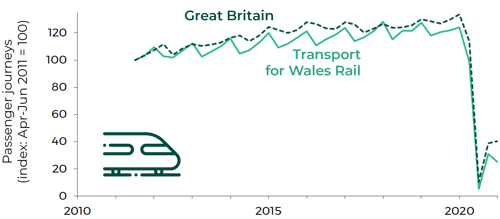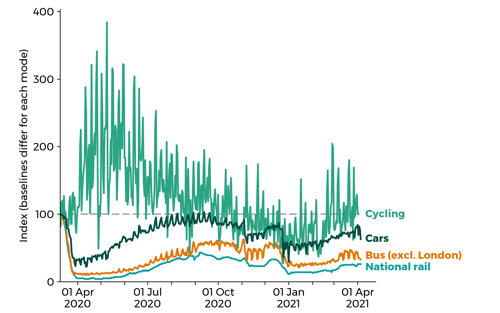This article is part of our 'What's next? Key issues for the Sixth Senedd' collection.
Bus and rail services are having a tough time in the pandemic. How can Welsh transport policy put them back on their feet and why does it matter?
The performance of bus and rail services has been a concern for years. However, the pandemic has seen a collapse in passenger numbers and revenue. Both modes have been on life support since last March.
Recovery of the sector will be important if Wales is to achieve some key socio-economic and environmental priorities. Yet future demand, and even the post-pandemic purpose of these transport modes, is unclear.
An effective response from policy makers and practitioners in the Sixth Senedd will be crucial to get public transport back on the road (and rails) to recovery.
What’s happened to passenger numbers?
Public transport issues are not new. Bus passenger numbers have declined for about a decade. In contrast, rail passengers have grown steadily, but overcrowding and aging trains have dogged Arriva Trains Wales, and subsequently Transport for Wales (TfW) Rail.
Passenger journeys on local bus services index April-June 2010 to October – December 2020

Source: Quarterly bus statistics, UK Department for Transport
Rail passenger journeys index for Transport for Wales and Great Britain April- June 2011 to October – December 2020

Source: Passenger rail usage, Office of Rail and Road
The pandemic’s impact has been shattering. Bus and rail passenger numbers have collapsed. The Welsh Government has estimated that the use of public transport declined by 95% in the early days of the pandemic compared to the same period the year before.
Given the impact on congestion and the environment, it’s also concerning that car usage, for Great Britain as a whole, has recovered much more rapidly than bus and rail – a fact attributed by RAC research partly to safety concerns and lack of adequate alternatives.
Estimated use of transport modes in Great Britain since March 2020

Source: Transport use during the coronavirus (COVID-19) pandemic, UK Department for Transport
Note: The UK Department for Transport published a note on methodology for this data outlining its limitations. Baselines differ for each mode.
Why does public transport matter?
Public transport helps address key socio-economic issues like social inclusion and access to work. A quarter of households lack car access and the Bevan Foundation has highlighted public transport’s role in supporting social inclusion including for older people and those on low incomes.
Evidence to the Senedd’s Petitions Committee said one in five job offers at Deeside Industrial Park are turned down because of poor public transport or road congestion.
Public transport has environmental benefits. Road transport is a significant cause of air pollution and poor air quality, so low emission buses and rail services can improve air quality. In terms of climate change, the UK Climate Change Committee highlights, in its latest advice report to the Welsh Government, that surface transport more generally contributes 14% of Welsh greenhouse gas emissions, higher per capita than for the UK as a whole. The CCC identifies public transport and active travel as priorities for Welsh decarbonisation.
Public transport on life support
The last Welsh Government responded to the collapse in passenger numbers by immediately putting bus and TfW Rail services on life support, with an initial round of emergency financial support in March 2020
Further support for rail followed last May before the Welsh Government announced in the autumn that TfW would take rail services into public ownership as “operator of last resort”. A move expected to last at least five years.
Initial support for bus services merged with wider reform priorities to become a new Bus Emergency Scheme (see box 1).
Together, both modes received about £200 million of additional Welsh Government funding in 2020-21, with more to come in 2021-22.
|
Bus reform With plans for a Bus Services Bill shelved due to the pandemic, the last Welsh Government introduced the Bus Emergency Scheme, The previous Welsh Government anticipated this increased role for government would endure, and also continued to develop legislation |
What’s the plan for recovery?
Many countries and cities are focusing transport recovery on sustainable mobility, including public transport. In Wales, and more widely in Great Britain, NGOs like Transport Focus, the Campaign for Better Transport and Transform Cymru have published post-COVID-19 priorities supporting this approach.
The previous Welsh Government published a new Wales Transport Strategy in March which reflects its wider post-COVID-19 reconstruction priorities. The strategy prioritises reducing the need to travel, along with a shift from the private car to more sustainable modes. Significantly, it includes a target to increase the share of journeys by public transport and active travel from 32% to 45% by 2040.
Along with bus reform, the success of the three planned Metro systems will be crucial to public transport recovery, as will plans to address M4 congestion around Newport (box 2) and new transport governance arrangements (box 3).
|
The future of the M4 corridor around Newport The Burns Commission published final recommendations on alternatives to the M4 relief road last November, focusing on public transport. The UK Government has announced funding for exploratory work on Lord Burns’ rail recommendations. However, the Prime Minister supports a relief road, and the Secretary of State has described it as “the most obvious” solution to congestion. |
|
Transport governance Corporate Joint Committees (CJCs) are being established to deliver some Welsh local government functions regionally, including transport planning. The last Welsh Government saw its transport body, TfW, as a “go-to” delivery body for these CJCs. Yet local government has not always been clear on the relationship between TfW and proposed regional transport structures. This relationship will be crucial to achieving the aims of the new transport strategy and public transport recovery. |
However, not all policy levers currently sit within Wales. In particular, UK Government plans to reform rail in Great Britain could have big implications for Wales (box 4).
|
Rail reform While the Welsh Government has executive powers, particularly in relation to rail services, rail is largely reserved. The UK Government has overall control of the rail system, including Welsh rail infrastructure outside the Core Valleys Network. The last Welsh Government believed Wales has been short changed on rail infrastructure enhancement spending, and developed a strategic case for investment. The UK Government announced the outcome of a fundamental review of rail in Great Britain on 20 May. This proposes a new centralised “guiding mind” – Great British Railways - for the system across Britain. “Devolved authorities” would continue to exercise their current powers, and a new “joint working agreement” would be implemented between Wales and the new body. The full implications for Wales remain to be seen, but many of the last Welsh Government’s key asks from the process don’t appear to be on the way. |
A new purpose for public transport?
Once the crisis point has past, the question of what post-pandemic public transport will look like will remain.
The previous Welsh Government highlighted uncertainty around the pandemic’s impact on future travel demand. Public opinion surveys and work by Transport Focus suggest a long-term change in travel habits and demand, not least if remote working becomes more established as the previous Welsh Government intended.
The next Welsh Government’s transport policy will need to ensure bus and rail services are able to adapt to their new purpose, if the ambitious targets in the new transport strategy are to be retained and met.
In doing so, it will also need to address perennial issues like integration with other modes, coordinating with trip generating policy areas like health and land-use planning, addressing congestion and managing demand.
The new Welsh Government will have its work cut out.
Article by Andrew Minnis, Senedd Research, Welsh Parliament






